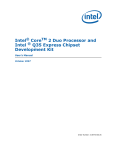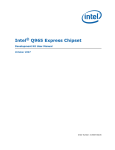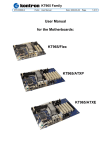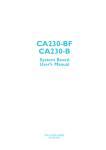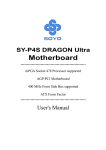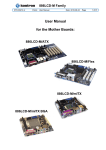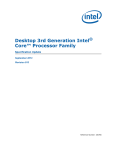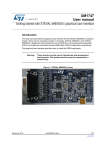Download Manual: Intel® Core™2 Duo Processor and Intel® Q45 Express
Transcript
Intel® Core™ 2 Duo Processor and Intel® Q45 Express Chipset Development Kit User’s Manual September 2008 Revision 001 Document Number: 320632-001US INFORMATION IN THIS DOCUMENT IS PROVIDED IN CONNECTION WITH INTEL® PRODUCTS. NO LICENSE, EXPRESS OR IMPLIED, BY ESTOPPEL OR OTHERWISE, TO ANY INTELLECTUAL PROPERTY RIGHTS IS GRANTED BY THIS DOCUMENT. EXCEPT AS PROVIDED IN INTEL'S TERMS AND CONDITIONS OF SALE FOR SUCH PRODUCTS, INTEL ASSUMES NO LIABILITY WHATSOEVER, AND INTEL DISCLAIMS ANY EXPRESS OR IMPLIED WARRANTY, RELATING TO SALE AND/OR USE OF INTEL PRODUCTS INCLUDING LIABILITY OR WARRANTIES RELATING TO FITNESS FOR A PARTICULAR PURPOSE, MERCHANTABILITY, OR INFRINGEMENT OF ANY PATENT, COPYRIGHT OR OTHER INTELLECTUAL PROPERTY RIGHT. UNLESS OTHERWISE AGREED IN WRITING BY INTEL, THE INTEL PRODUCTS ARE NOT DESIGNED NOR INTENDED FOR ANY APPLICATION IN WHICH THE FAILURE OF THE INTEL PRODUCT COULD CREATE A SITUATION WHERE PERSONAL INJURY OR DEATH MAY OCCUR. Intel may make changes to specifications and product descriptions at any time, without notice. Designers must not rely on the absence or characteristics of any features or instructions marked "reserved" or "undefined." Intel reserves these for future definition and shall have no responsibility whatsoever for conflicts or incompatibilities arising from future changes to them. The information here is subject to change without notice. Do not finalize a design with this information. The products described in this document may contain design defects or errors known as errata which may cause the product to deviate from published specifications. Current characterized errata are available on request. Contact your local Intel sales office or your distributor to obtain the latest specifications and before placing your product order. 45-nm products are manufactured on a lead-free process. Lead-free per EU RoHS directive July, 2006. Some E.U. RoHS exemptions may apply to other components used in the product package. Residual amounts of halogens are below November, 2007 proposed IPC/JEDEC J-STD-709 standards. This device is protected by U.S. patent numbers 5,315,448 and 6,516,132, and other intellectual property rights. The use of Macrovision's copy protection technology in the device must be authorized by Macrovision and is intended for home and other limited pay-per-view uses only, unless otherwise authorized in writing by Macrovision. Devices incorporating Macrovision’s copy protection technology can only be sold or distributed to companies appearing on Macrovision’s list of “Authorized Buyers” at: www.macrovision.com. Reverse engineering or disassembly is prohibited. Intel, Celeron, Intel Core, Intel Speedstep, and the Intel logo are trademarks of Intel Corporation in the U.S. and other countries. *Other names and brands may be claimed as the property of others. Copyright © 2008, Intel Corporation. All rights reserved. 2 User’s Manual Contents 1 Introduction .....................................................................................................7 1.1 1.2 1.3 1.4 1.5 2 Development Kits Hardware Features................................................................. 12 2.1 2.2 2.3 2.4 2.5 2.6 2.7 2.8 2.9 3 Overview ............................................................................................31 ATX Heatsink Setup ..............................................................................32 ATX Heatsink Alignment on the Intel® Q45 Development Kit Platform ......... 32 Board Setup and Configuration before Boot .............................................. 34 3.4 Post Codes Definitions ..................................................................... 35 3.5.1 Normal Post Codes .................................................................. 36 BIOS Setup Utility...........................................................................................42 4.1 User’s Manual Intel® Q45 Development Kits Overview................................................... 12 System Block Diagram .......................................................................... 13 Development Kit Inventory Checklist....................................................... 14 Processor Support ................................................................................ 15 System Memory ...................................................................................15 2.5.1 Dual Channel (Interleaved) Mode Configurations.......................... 16 2.5.2 Single Channel (Asymmetric) Mode Configurations ....................... 18 Back-Panel Connectors.......................................................................... 19 2.6.1 Audio-Connectors .................................................................... 20 2.6.2 RJ-45 LAN Connector with Integrated LEDs ................................. 21 2.6.3 USB Port ................................................................................21 2.6.4 HDMI Port .............................................................................. 21 Debug Features....................................................................................22 2.7.1 Extended Debug Probe (XDP).................................................... 22 2.7.2 Power LEDs ............................................................................ 23 2.7.3 Port 80 POST Code LEDs .......................................................... 23 2.7.4 Voltage Reference ................................................................... 23 Development Kit’s Major Connector and Jumper........................................ 24 2.8.1 Jumper Functions ....................................................................24 2.8.2 USB 2.0 Front Panel ................................................................ 25 2.8.3 1394a Header .........................................................................26 SPI Removal / Installation Technique................................................... 28 2.9.1 SPI Device Installation ............................................................. 28 2.9.2 SPI Device Removal................................................................. 30 Setting Up and Configuring Development Kits ..................................................... 31 3.1 3.2 3.3 3.4 3.5 4 Content Overview...................................................................................7 Text Conventions ...................................................................................8 Terminology ..........................................................................................9 Support Options ...................................................................................10 1.4.1 Electronic Support Systems ...................................................... 10 1.4.2 Additional Technical Support ..................................................... 10 Product Literature ................................................................................ 11 Main...................................................................................................42 3 4.2 4.3 4.4 4.5 4.6 4.7 4.8 4.9 System Overview .................................................................... 42 4.1.1 Advance..............................................................................................43 PCIPnP ...............................................................................................48 Boot ...................................................................................................48 4.4.1 Boot Setting Configuration........................................................ 48 Security ..............................................................................................49 Chipset ............................................................................................... 50 Virtual Appliance ..................................................................................55 System Validation (SV) .........................................................................56 Exit ....................................................................................................57 Figures Figure Figure Figure Figure Figure Figure Figure Figure Figure Figure Figure Figure Figure Figure Figure Figure Figure Figure Figure Figure Figure Figure Figure Figure Figure Figure Figure Figure 4 2-1. Board Features ...............................................................................12 2-2. Intel® Q45 Development Kits Block Diagram ...................................... 13 2-3. Memory Channel and DIMM Configuration ..........................................16 2-4. Dual Channel (Interleaved) Mode Configuration with 2X DIMMs ............. 16 2-5. Dual Channel (Interleaved) Mode Configuration with 3X DIMMs ............. 17 2-6. Dual Channel (Interleaved) Mode Configuration with 4x DIMMs ............. 17 2-7. Single Channel (Asymmetric) Mode Configuration with 1X DIMM............ 18 2-8. Single Channel (Asymmetric) Mode Configuration with 3x DIMMs .......... 18 2-9. Back Panel Connectors for Development Kits ...................................... 19 2-10. LAN Connector LED Locations ......................................................... 21 2-11. ITP-XDP Connector Location (J2BC) ................................................. 22 2-12. Major Jumpers and Headers Location on the Development Kits ............ 24 2-13. USB 2.0 Front Panel ...................................................................... 25 2-14. USB 2.0 Front Panel ...................................................................... 26 2-15. Location for 1394a Header and USB Front Panel ................................ 27 2-16. Pick and Tweezer .......................................................................... 28 2-17. Doors 1 and 2 ..............................................................................28 2-18. Opening Door 1 ............................................................................29 2-19. Opening Door 2 ............................................................................29 2-20. Installing the SPI Device ................................................................29 2-21. Closing Doors 1 and 2.................................................................... 30 2-22. Removing the SPI Device ............................................................... 30 3-1. Intel® Q45 Development Kit ............................................................ 31 3-2. Intel® Q45 Development Kit Platform and the ATX Heatsink ................. 32 3-3. ATX Heatsink Alignment on the Intel® Q45 Development Kit Board ....... 33 3-4. Pressing the ATX Heatsink While Holding the Board .............................33 3-5. CPU Fan Location............................................................................ 34 3-6. 2x12 Standard Power Supply and 2x2 Power Supply ............................ 35 User’s Manual Tables Table Table Table Table Table Table Table Table Table Table Table Table Table Table Table Table Table Table Table Table Table Table Table Table Table Table Table Table Table Table Table Table User’s Manual 1-1. Intel Literature Centers.....................................................................11 2-1. LAN Connector LED Status ................................................................ 21 2-2. Voltage Reference Detail ...................................................................23 2-3. Intel® Q45 Development Kits CRB Board Jumpers Description ............... 24 2-4. USB Front Panel...............................................................................25 2-5. 1394a Header .................................................................................26 3-1. Boot Block Initialization Code Checkpoints ........................................... 36 3-2. Boot Block Recovery Code Check Points .............................................. 38 3-3. Runtime POST Code Checkpoints........................................................ 39 4-1. CPU Configuration ............................................................................43 4-2. IDE Configuration ............................................................................44 4-3. Floppy Configuration ........................................................................45 4-4. ACPI Configuration...........................................................................45 4-5. AHCI Configuration ..........................................................................46 4-6. Intel AMT Configuration ....................................................................46 4-7. MPS Configuration............................................................................47 4-8. SMBIOS Configuration ......................................................................47 4-9. Remote Access Configuration............................................................. 47 4-10. Trusted Computing ......................................................................... 47 4-11. USB Configuration ..........................................................................47 4-12. PCIPnP Configuration ......................................................................48 4-13. Boot Setting Configuration............................................................... 48 4-14. Boot Setting Configuration............................................................... 49 4-15. Northbridge Configuration ...............................................................50 4-16. Southbridge Configuration ...............................................................52 4-17. Intel ME Subsystem Configuration ....................................................53 4-18. PCI Express Configuration ...............................................................54 4-19. VE Subsystem Configuration ............................................................ 55 4-20. Virtual Appliance ............................................................................55 4-21. SV SMI Management ...................................................................... 56 4-22. SV SATA Management ....................................................................56 4-23. Exit ..............................................................................................57 5 Revision History Revision Number 001 Description Revision Date • Initial release. September 2008 § 6 User’s Manual Introduction 1 Introduction This user’s manual describes the use of the Intel® Q45 Express Chipset Development Kit. This manual has been written for OEMs, system evaluators, and embedded system developers. All jumpers, headers, LED functions, and their locations on the board, along with subsystem features and POST codes, are defined in this document. For the latest information about the Intel® Q45 Express Chipset Development Kit reference platform, visit: http://developer.intel.com/design/intarch/devkits/index.htm?iid=embed_body+devkits For design documents related to this platform, such as schematics and layout, please contact your Intel Representative. 1.1 Content Overview Chapter 1, “About This Manual” – This chapter contains a description of conventions used in this manual. The last few sections explain how to obtain literature and contact customer support. Chapter 2, “Development Kits Hardware Features” – This chapter provides information on the development kit features and the board capability. This includes the information on board component features, jumper settings, pin-out information for connectors and overall development kit board capability. Chapter 3, “Development Kits Board ” – This chapter provides instructions on how to configure the evaluation board and processor assembly by setting ATX heatsink, jumpers, connecting peripherals, providing power, and configuring the BIOS. Chapter 4, “BIOS Setup Utility” – This chapter provides the BIOS function and how to configure the BIOS features. This includes the BIOS option tab functions like the Main System Overview, Advance, PCIPnP, Boot, Security, Chipset, SV, and Exit. User’s Manual 7 Introduction 1.2 Text Conventions The following notations may be used throughout this manual. # The pound symbol (#) appended to a signal name indicates that the signal is active low. Variables Variables are shown in italics. Variables must be replaced with correct values. Instructions Instruction mnemonics are shown in uppercase. When you are programming, instructions are not case-sensitive. You may use either uppercase or lowercase. Numbers Hexadecimal numbers are represented by a string of hexadecimal digits followed by the character H. A zero prefix is added to numbers that begin with A through F. (For example, FF is shown as 0FFH.) Decimal and binary numbers are represented by their customary notations. (That is, 255 is a decimal number and 1111 1111 is a binary number.) In some cases, the letter B is added for clarity. Units of Measure The following abbreviations are used to represent units of measure: Signal Names 8 GByte gigabytes KByte kilobytes MByte megabytes MHz megahertz W watts V volts Signal names are shown in uppercase. When several signals share a common name, an individual signal is represented by the signal name followed by a number, while the group is represented by the signal name followed by a variable (n). For example, the lower chip-select signals are named CS0#, CS1#, CS2#, and so on; they are collectively called CSn#. A pound symbol (#) appended to a signal name identifies an active-low signal. Port pins are represented by the port abbreviation, a period, and the pin number (e.g., P1.0). User’s Manual Introduction 1.3 Terminology Term ADD2 Card Advanced Digital Display Card – second generation. This card provides digital display options for an Intel Graphics Controller that supports ADD2+ cards. It plugs into a x16 PCI Express* connector but uses the multiplexed SDVO interface. The card adds video in capabilities to the platform. This Advanced Digital Display Card will not work with an Intel Graphics Controller that supports DVO and ADD cards. It will function as an ADD2 card in an ADD2 supported system, but video in capabilities will not work. ACPI Advanced Configuration and Power Interface. Core The internal base logic in the (G) MCH. DDR3 A third generation Double Data Rate SDRAM memory technology. DMI (G)MCH-Intel® ICH10 Direct Media Interface. DVI Digital Video Interface. Specification that defines the connector and interface for digital displays. FSB Front Side Bus. FSB is synonymous with the host or processor bus. GMA 4500 ® User’s Manual Description Intel® Graphic Media Accelerator 4500. Intel ICH10 Ninth generation I/O Controller Hub component that contains additional functionality compared to previous ICHs. The I/O Controller Hub component contains the primary PCI interface, LPC interface, USB2, ATA-100, and other I/O functions. It communicates with the (G)MCH over a proprietary interconnect called DMI. IGD Internal Graphics Device. LVDS Low Voltage Differential Signaling. A high speed, low power data transmission standard used for display connections to LCD panels. MCH Memory Controller Hub component that contains the processor interface, DRAM controller, and x16 PCI Express* port (typically, the external graphics interface). It communicates with the I/O controller hub (Intel® ICH10) and other I/O controller hubs over the DMI interconnect. In this document MCH refers to the Intel® Q45 MCH component. MEC Media Expansion Card, also known as ADD2+ card. Refer to ADD2+ term for description. PCI Express* Third Generation input/output graphics attach called PCI Express* Graphics. PCI Express* is a high-speed serial interface whose configuration is software compatible with the existing PCI specifications. The specific PCI Express* implementation intended for connecting the (G)MCH to an external Graphics Controller is a x16 link and replaces AGP. Primary PCI The Primary PCI is the physical PCI bus that is driven directly by the ICH10 component. Communication between Primary PCI and the (G)MCH occurs over DMI. Note that the Primary PCI bus is not PCI Bus 0 from a configuration standpoint. 9 Introduction Term Description Rank A unit of DRAM corresponding to eight x8 SDRAM devices in parallel or four x16 SDRAM devices in parallel, ignoring ECC. These devices are usually, but not always, mounted on a single side of a DIMM. SDVO Serial Digital Video Out (SDVO). SDVO is a digital display channel that serially transmits digital display data to an external SDVO device. The SDVO device accepts this serialized format and then translates the data into the appropriate display format (i.e., TMDS, LVDS, TV-Out). This interface is not electrically compatible with the previous digital display channel - DVO. For the 82Q965 GMCH, it will be multiplexed on a portion of the x16 graphics PCI Express* interface. SDVO Device Third party codec that uses SDVO as an input. It may have a variety of output formats, including DVI, LVDS, HDMI, TV-out, etc. SMI System Management Interrupt. SMI is used to indicate any of several system conditions (such as, thermal sensor events, throttling activated, access to System Management RAM, chassis open, or other system state related activity). Virtual Appliance (VA) A software stack that brings to the personal computer unprecedented levels of security and manageability for the IT professional. 1.4 Support Options 1.4.1 Electronic Support Systems Intel’s site on the World Wide Web (http://www.intel.com/) provides up-to-date technical information and product support. This information is available 24 hours per day, 7 days per week, providing technical information whenever you need it. Product documentation is provided online in a variety of web-friendly formats at: http://developer.intel.com/literature/index.asp 1.4.2 Additional Technical Support If you require additional technical support, please contact your field sales representative or local distributor. 10 User’s Manual Introduction 1.5 Product Literature Product literature can be ordered from the following Intel literature centers. Table 1-1. Intel Literature Centers Location User’s Manual Telephone Number U.S. and Canada 1-800-548-4725 U.S. (from overseas) 708-296-9333 Europe (U.K.) 44(0)1793-431155 Germany 44(0)1793-421333 France 44(0)1793-421777 Japan (fax only) 81(0)120-47-88-32 11 Development Kits Hardware Features 2 Development Kits Hardware Features This chapter describes the development kit features of the Intel® Q45 Development Kits. These recommendations would largely apply to other designs incorporating Intel® Q45 chipset. This documentation should be used in conjunction with the Intel® Q45/ICH10 datasheet, specification updates and platform design guides. Contact your local Intel representative for the availability of these documents. 2.1 Intel® Q45 Development Kits Overview Figure 2-1 shows overview of the major features present on the development kit board. Refer to next page for system block diagram of the development kit’s motherboard. Figure 2-1. Board Features Port 80 LED Display 2x2 Standard Power Supply PCI Slot PCI Express X1 Slot LGA775 Processor Socket PCI Express X16 Graphic Slot Intel® Q45 Memory Controller Hub (MCH) Power On Button Intel® I/O Controller Hub (ICH) 2-DIMM per Channel DDR2 667/800 (Channel-A) 2-DIMM per Channel DDR2 667/800 (Channel-B) 2x12 Standard Power Supply SATA Port § 12 User’s Manual Development Kits Hardware Features 2.2 System Block Diagram This section will document the common features that are applicable to Intel® Q45 Express Chipset Development Kits. Figure 2-2 shows a simple block diagram of the Intel® Q45 Express Chipset Development Kits. Figure 2-2. Intel® Q45 Development Kits Block Diagram LGA775 Processor SMBus Resume PCI Express Graphic X16 slot (Primary) Clock X16 PCI Express SMBus Main 1033 MT/s Graphics Memory Controller Hub (GMCH) Integrated Graphic VGA Output SP Flash Devic SATA port 5 SATA port 4 SATA port 3 SATA port 2 SATA port 1 SATA port 0 DDR3 Dual Channel DDR3 1066 DDR3 X1 PCI Express PCIE Slot SPI I/O Controller Hub (ICH) PCI Bus PCI Slot PCI SMBus Resume 1394 SMBus USB 2.0 HD Audio USB Front Panel Back Panel USB or LAN USB or 1394 USB User’s Manual 13 Development Kits Hardware Features 2.3 Development Kit Inventory Checklist This section describes major hardware items that should be available in the development kit. Development Kit Hardware Items 1x 4-layer Micro-ATX form factor (targeted dimensions: 10.5” x 10.4”) motherboard 1x Intel® CoreTM 2 Duo E8400 Processors in the LGA775 socket 2x 1 GBytes DDR3 800 DIMM 1x ATX heatsink with fan 1x CD-ROM containing chipset drivers (this include Intel® GMA4500 driver) Development Kit Board Specification 1 PCI Express x16, 3 PCIe x1, 3 PCI expansion slots 1394a 1 front panel headers for support of 1 port 1 back panel port Universal Serial Bus 2.0 3 front panel headers for support of 6 ports 6 back panel ports 6 SATA 3 Gb/sec ports Internal I/O Headers 2x5 front panel I/O header 2x5 front panel audio header 1x2 chassis intrusion header 3 four-wire fan headers 2x8 high definition audio header Additional Features 5 analog audio connectors and 1 high definition media interface (HDMI) Piezo speaker for BIOS POST codes BIOS configuration jumper Clear CMOS jumper Power button Reset button XDP connector 14 User’s Manual Development Kits Hardware Features 2.4 Processor Support Intel® Q45 Development Kits support the following processors in the LGA775 socket with FSB of 800/1067/1333 MHz. Processors listed here have long-life support and are also supported by this development kits. • Intel® CoreTM 2 Duo E8400 Series • Intel® CoreTM 2 Duo E6400 Series • Intel® CoreTM 2 Duo E4300 Series • Intel® Celeron® 440 Refer to this link for other processors which is also supported by Intel® Q45 Express Chipset: http://developer.intel.com/products/chipsets/Q35_Q33/index.htm. 2.5 System Memory The Intel® Q45 MCH supports two types of memory organization: interleaved mode and asymmetric mode. Supported system memory types are as follows: • Non-ECC DDR3 (800/1066) • 512Mb, 1Gb, and 2Gb technology • 4 DIMMs, 8GB maximum per channel, 16GB total memory The modes of organization are as follows: • Dual channel (Interleaved) mode. This mode offers the highest throughput for real world applications. Dual channel mode is enabled when the installed memory capacities of both DIMM channels are equal. Technology and device width can vary from one channel to the other but the installed memory capacity for each channel must be equal. If DIMMs of different speeds are used between channels, the slowest memory timing will be used. • Single channel (Asymmetric) mode. This mode is equivalent to single channel bandwidth operation for real world applications. This mode is used when only a single DIMM is installed or the memory capacities are unequal. Technology and device width can vary from one channel to the other. If DIMMs of different speeds are used between channels, the slowest memory timing will be used. Figure 2-3 illustrates the memory channel and DIMM configuration. User’s Manual 15 Development Kits Hardware Features Figure 2-3. Memory Channel and DIMM Configuration Channel A DIMM 0 Channel A DIMM 1 Channel B DIMM 0 Channel B DIMM 1 2.5.1 Dual Channel (Interleaved) Mode Configurations Figure 2-4 shows a dual channel configuration using two DIMMs. In this example, the DIMM 0 sockets of both channels are populated with identical DIMMs. Figure 2-4. Dual Channel (Interleaved) Mode Configuration with 2X DIMMs Figure 2-5s shows a dual channel configuration using three DIMMs. In this example, the combined capacity of the two DIMMs in Channel A equal the capacity of the single DIMM in the DIMM 0 socket of Channel B. 16 User’s Manual Development Kits Hardware Features Figure 2-5. Dual Channel (Interleaved) Mode Configuration with 3X DIMMs Figure 2-6. Dual Channel (Interleaved) Mode Configuration with 4x DIMMs User’s Manual 17 Development Kits Hardware Features 2.5.2 Single Channel (Asymmetric) Mode Configurations Figure 2-7 shows a single channel configuration using 1x DIMM. In this example, only the DIMM 0 socket of Channel A is populated. Channel B is not populated. Figure 2-7. Single Channel (Asymmetric) Mode Configuration with 1X DIMM Figure 2-8 shows a single channel configuration using 3x DIMMs. In this example, the combined capacity of the 2x DIMMs in Channel A does not equal the capacity of the single DIMM in the DIMM 0 socket of Channel B. Figure 2-8. Single Channel (Asymmetric) Mode Configuration with 3x DIMMs 18 User’s Manual Development Kits Hardware Features 2.6 Back-Panel Connectors Figure 2-9 show back panel connectors for the development kits. Figure 2-9. Back Panel Connectors for Development Kits 1394a port RJ-45 LAN Port Rear Speaker Out Line In Jack USB Port VGA Analog Display HDMI Port User’s Manual Line Out Jack Center/Subwoofer Speaker Out Jack SPIF Port Mic In Jack 19 Development Kits Hardware Features 2.6.1 Audio-Connectors This development kits board support up to 5.1-channel audio configuration. It’s backward compatible with 5.1, 2.1 and high definition media interface audio/video configuration as well. • Line In Jack (Light Blue) This audio jack is used to for line in devices. It’s used in some optical devices and much more. • Line Out Jack (Light Green) This audio jack is used for line out devices. It’s used in 2.1, 5.1 and 7.1 channelaudio configuration. It can be used for headphone and stereo speaker as well. • Mic In Jack (Pink) This audio jack is use for microphone input. • Center/Subwoofer Speaker Out Jack (Orange) This audio jack is used to connect to center/subwoofer speakers in a 5.1 and 7.1 channel audio configuration. If the audio is other than 5.1 and 7.1, the connector can be left unconnected. • Rear Speaker Out (Black) This audio jack is used to connect to rear speakers in a 5.1 and 7.1 channel audio configuration. 20 User’s Manual Development Kits Hardware Features 2.6.2 RJ-45 LAN Connector with Integrated LEDs Two LEDs are built into the RJ-45 LAN connector (as shown in Figure 2-10). Table 2-1 describes the LED states when the board is powered up and the gigabit LAN subsystem is operating. Figure 2-10. LAN Connector LED Locations Table 2-1. LAN Connector LED Status LED Left Color Green LED State Off LAN link is not established. On LAN link is established. Blinking Right 2.6.3 Condition LAN activity is occurring. N/A Off 10 Mbits/sec data rate is selected. Green On 100 Mbits/sec data rate is selected. Yellow On 1000 Mbits/sec data rate is selected. USB Port The USB port supports the USB 1.1/2.0 specification. 2.6.4 HDMI Port This connector provides digital audio input and output from external audio system that supports digital audio data. Please ensure that the audio system provides a HDMI connector. User’s Manual 21 Development Kits Hardware Features 2.7 Debug Features 2.7.1 Extended Debug Probe (XDP) The reference board provides a JTAG-compliant test access port (TAP) for attachment of an XDP connector. The XDP connector and associated circuitry enable the use of the ITP for the particular processor to interrupt the boot sequence and view processor status. The XDP connector is located on the backside of the board at location J2BC. Refer to Figure 2-11 for the XDP connector location. Note that ITP-XDP SSA connector is needed. Refer to diagram below for the ITP-XDP SSA connector. Figure 2-11. ITP-XDP Connector Location (J2BC) ITP-XDP Connector ITP-XDP SSA Connector is needed to connect to ITP-XDP2/3 tools 22 User’s Manual Development Kits Hardware Features 2.7.2 Power LEDs Power LEDs on the board indicate when standby power is being applied to the standby planes. When lit they indicate that no DIMM modules should be inserted or removed. To install or replace DIMM modules ensure that AC power to the power supply is removed by unplugging the AC power cord from the power supply or placing the switch on the power supply to the open position. Caution: Removing DIMM modules when the standby power LEDs is lit could result in damage to the memory devices on those modules. 2.7.3 Port 80 POST Code LEDs Two LEDs display the POST codes output from Port 80 to indicate the progress of the boot sequence or display the POST code of the last operation successfully completed during the boot sequence. Please refer to Section 3.4 for more information on Port 80 code reference. 2.7.4 Voltage Reference See Table 2-2 for details of the expected voltage levels for each voltage rail on the CRB. Table 2-2. Voltage Reference Detail Voltage Rail Voltage Rail Expected Voltage VCC 5.0 V_1P1_CORE 1.1 VCC3 3.3 V_1P1_CL_MCH 1.1 +12V 12 V_1P1_PCIEXPRESS 1.1 -12V -12 V_SM 1.5 V_5P0_STBY\G 5.0 V_SM_VTT 0.75 V_3P3_STBY\G 3.3 V_1P1_CL 1.1 V_1P5_ICH 1.5 V_3P3_PCIVAUX 3.3 VCC_DMI 1.1 VDD_CLK 3.3 V_FSB_VTT 1.1 VCC_CPU_IO 1.1 VCCP User’s Manual Expected Voltage 1.15-1.50 23 Development Kits Hardware Features 2.8 Development Kit’s Major Connector and Jumper Figure 2-12 shows major jumpers and headers use on the development kits. Figure 2-12. Major Jumpers and Headers Location on the Development Kits J4LB/J10LB J6LB J14LB J7LB J15LB J115LB J16LB 2.8.1 Jumper Functions Table 2-3 provides a list of the setting definitions Intel® Q45 Development Kits CRB. Table 2-3. Intel® Q45 Development Kits CRB Board Jumpers Description Jumper J6LB Description Clear CMOS Positions 1-2: normal Default Position 1-2 2-3: clear CMOS J115LB RTC reset 1-2: normal 1-2 2-3: clear J7LB Configuration/recovery 1-2: normal 1-2 2-3: configure, jumper removed – recovery J4LB/J10LB Manufacturing mode Empty Enable if jumper plug-in 24 User’s Manual Development Kits Hardware Features 2.8.2 USB 2.0 Front Panel Four USB 2.0 ports can be found on the front panel of the development kit board. Front panel USB header thermistor protection is required. The USB front panel is labeled as J14LB, J15LB, J16LB and J1FW on the boards. Refer to Figure 2-13 for the USB front panel. Figure 2-13. USB 2.0 Front Panel Table 2-4. USB Front Panel Pin Number 1 5V 2 5V 3 USB Dx- 4 USB Dy- 5 USB Dx+ 6 USB Dy+ 7 GND 8 GND 9 No pin 10 User’s Manual Definition No connect 25 Development Kits Hardware Features 2.8.3 1394a Header There is one 1394a port on the back panel. Refer to Figure 2-9 for the back panel 1394a locations. There is another header supporting the 1394a port, which is shown in Figure 2-15. Front panel 1394a header thermistor protection is required. The IEEE 1394a connectors are colored blue. The +12 V DC power on the IEEE 1394a connectors is fused. Each IEEE 1394a connector provides one IEEE 1394a port. Figure 2-14. USB 2.0 Front Panel Table 2-5. 1394a Header Pin Number 26 Definition 1 TP A+ 2 TP A- 3 Ground 4 Ground 5 TP B+ 6 TP B- 7 +12V DC 8 +12V DC 9 No Pin 10 Ground User’s Manual Development Kits Hardware Features Figure 2-15. Location for 1394a Header and USB Front Panel J24LB 1394a Header USB front panel User’s Manual 27 Development Kits Hardware Features 2.9 SPI Removal / Installation Technique When removing or installing the SPI device care must be taken to avoid damage to the SPI socket. The cap is constructed of plastic and can easily be damaged. 2.9.1 SPI Device Installation Suggested tooling to use for install and removal other basic FA equipment may be needed but not necessary. Figure 2-16. Pick and Tweezer 1. The door is identified prior to install or removal of SPI device Figure 2-17. Doors 1 and 2 2. 28 As shown, the door must be opened to avoid damage to the socket. Door 1 is identified by the lip, as pointed out. Using the pick, gently push up from under the lip to open door 1. User’s Manual Development Kits Hardware Features Figure 2-18. Opening Door 1 Figure 2-19. Opening Door 2 3. With socket doors open, the SPI device can be installed. Align the SPI device with the guide slots. No pressure need be applied. Note: Early versions of the Lotes* socket does not account for pin 1 orientation on the socket. Figure 2-20. Installing the SPI Device 4. Gently close each socket door in reverse order until socket doors are closed. Note: Pressure will be applied with the socket doors closed to ensure contact between socket and the SOIC 8 component. User’s Manual 29 Development Kits Hardware Features Figure 2-21. Closing Doors 1 and 2 2.9.2 SPI Device Removal Follow the same steps to get doors open. Using tweezers, gently remove the SPI device from the socket. Gently close the socket doors, if not in use, to avoid any damage to the socket doors. Figure 2-22. Removing the SPI Device 30 User’s Manual Setting Up and Configuring Development Kits 3 Setting Up and Configuring Development Kits This chapter identifies the evaluation kit basic board’s set up and operation. Please refer to Chapter 2 for the board layout, jumper setting location and the component reference designator. 3.1 Overview Figure 3-1. Intel® Q45 Development Kit User’s Manual 31 Setting Up and Configuring Development Kits 3.2 ATX Heatsink Setup Depending on the ATX casing that user use, this guide only provides instructions for installing the ATX heatsink. Refer to Figure 3-2 for the heatsink figure. Figure 3-2. Intel® Q45 Development Kit Platform and the ATX Heatsink 3.3 ATX Heatsink Alignment on the Intel® Q45 Development Kit Platform Attach the ATX heatsink over the processor to the Intel® Q45 Development Kit platform by following procedures described below. 1. 32 Place the ATX heatsink on the Intel® Q45 Development Kit board so that the hole on the board line up with the corresponding ATX Heatsink location. The board and the ATX heatsink should look like Figure 3-3. User’s Manual Setting Up and Configuring Development Kits Figure 3-3. ATX Heatsink Alignment on the Intel® Q45 Development Kit Board 2. Press the ATX heatsink pin toward the hole on the board until “tick” sound can be heard. Remember to hold the board while pressing the pin. Refer to Figure 3-4. Figure 3-4. Pressing the ATX Heatsink While Holding the Board User’s Manual 33 Setting Up and Configuring Development Kits 3.4 Board Setup and Configuration before Boot Follow the steps below to operate the reference board. Start at step 1 with the power supply not connected to the board. 1. Physically inspect the motherboard for obvious defects. Note that each reference board has been tested prior to distribution; however, a visual check should be performed to ensure no damage has occurred in shipping. 2. Set jumpers to default positions. Refer to Table 2-3 for default positions. 3. Install the processor and ensure that the 4-pin CPU fan power connector is installed on header shown below. Figure 3-5. CPU Fan Location 4-pin CPU fan power 34 4. Install a DDR3 DIMM in the Channel A Slot 0 connector. DIMMs should never be inserted or removed unless the power supply is disconnected from the AC power source. Refer to Section 2.5 for system memory configuration. 5. Connect the SATA hard drive, USB keyboard, USB mouse, and VGA monitor (video card is optional). 6. Connect an 2x12 standard power supply and 2x2 also. Refer to Figure 3-6 for the location. User’s Manual Setting Up and Configuring Development Kits Figure 3-6. 2x12 Standard Power Supply and 2x2 Power Supply 2x2 standard power supply Power-on button 2x12 standard power supply 7. 3.5 Press the power button. Refer to Figure 3-6 or Figure 2-1 for the power-on button location. 3.4 Post Codes Definitions The CRB BIOS writes progress and error codes to Port 80 during POST. These codes are defined below. User’s Manual 35 Setting Up and Configuring Development Kits 3.5.1 Normal Post Codes Table 3-1. Boot Block Initialization Code Checkpoints Post 36 Code Description Before D0h Verifies that CMOS is valid. Interrupts are disabled. D0h Goes to flat mode with a 4GB limit and GA20 enabled. Performs early chipset initialization. D1h Initializes SIO devices. Programs the KBC command byte. Loads microcode. Checks if waking from power management suspend state. Saves power-on CPUID value in scratch CMOS. D2h Verifies Boot Block checksum. D3h Prepares memory for detection and sizing and jump to memory initialization code. A0h Sets default values used in memory initialization. A1h Calculates system bus frequency. A2h Enables MMIO space behind BAR and set base address for memory BAR. Read and store SPD data for later for all DIMMs present. A3h Sets bus ratio. A4h Gets column latency. A5h Checks rTAS, tRP, tRCD, and refresh timings. A6h Verifies that DIMMS are populated from farthest to closest slot away from MCH. A7h Jumps to SDRAM program. A8h Saves DIMM layout in CMOS. 7Ah Handles DDR2 dual rank special case. Enables clocks used by DIMMs. A9h Programs DRAMISCTRL, SDRC, DDRCSR B9h Programs DRM. AAh Translates logical DIMM number to physical DIMM number. B1h Calculates size variable (contains row, column and bank). B2h Gets MCH row memory size and attribute. ABh Programs the DRAs and DRBs. ACh Performs Jedec sequence on each row. ADh Makes call to program DRT register. B3h Programs MCH timings in DRT register. B4h Programs ODT mode for DDR2 DIMMs. 90h Checks for S3 resume. 91h Enables cache for data storage to be used with receive enable and DQS calibration. User’s Manual Setting Up and Configuring Development Kits Post User’s Manual Code Description 92h Copies data to Cache As Ram (CAR). 93h Calls receive enable calibration function. B6h Performs receive enable calibration. 94h Just before call to perform DQS calibration. B7h Performs the DQS calibration variable initialization. 70h Determines which rows are populated according to the DRBs. 71h Step 1 of DQS calibration. 72h Step 5 of DQS calibration. 73h Step 6 of DQS calibration. 74h End of DQS calibration. 9Fh Sets Top Of Memory register. B9h Programs MCH for particular refresh mode. BAh Performs memory test. B2h Programs ECC mode. AEh Sets the DDRCSR register. BCh Enables memory scrubbing. B3h Initializes other recommended MCH settings. BDh Programs the IC complete bit. AFh Saves S3 data, starts the refresh signal, and performs SB early initialization. D4h Tests base 512K memory. Adjusts policies and cache first 8MB. Sets stack. D5h Boot block code is copied from ROM to lower system memory and control is given to it. BIOS now executes out of RAM. Initializes DMA and interrupt controller. Forms ROM image. Checks BIOS checksum. D6h Control is in segment 0. If either the Ctrl button or the Home button was pressed, the BIOS checksum is bad, or the recovery bit is set in CMOS, next will go to checkpoint code E0h. Otherwise, goes to checkpoint code D7h. D7h Restore CPUID value back into register. The Boot block-Runtime interface module is moved to system memory and control is given to it. Determines whether to execute serial flash. D8h The runtime module is uncompressed into memory. CPUID information is stored in memory. D9h Stores uncompressed pointer for future use in PMM. Copies Main BIOS into memory. Leaves all RAM below 1MB read-write including E000 and F000 shadow areas but closing SMRAM. DAh Passing control to the main system BIOS in shadow RAM next. Initializes the interrupt vectors. 37 Setting Up and Configuring Development Kits Table 3-2. Boot Block Recovery Code Check Points Post 38 Code Description E0h The onboard floppy controller if available is initialized. Next, begins the base 512 KB memory test. E9h Looks for the floppy drive and reads the new ROM image from it. EAh Enables ATAPI hardware. Attempts to read from ARMD and ATAPI CDROM. EBh Disables ATAPI hardware. Jumps back to checkpoint E9h. D7h Recovery code not present. EFh A read error occurred on media. Jumps back to checkpoint EBh. F0h Searches for pre-defined recovery file name in root directory. F1h Recovery file not found. F2h Starts reading FAT table and analyzes FAT to find the clusters occupied by the recovery file. F3h Starts reading the recovery file cluster by cluster. F5h Disables L1 cache. FAh Check the validity of the recovery file configuration to the current configuration of the flash part. FBh Makes flash write enabled through the chipset and OEM-specific method. Detects proper flash part. Verifies that the found flash part size equals the recovery file size. F4h The recovery file size does not equal the found flash part size. FCh Erases the flash part. FDh Programs the flash part. FFh The flash has been updated successfully. Makes flash write disabled. Disables ATAPI hardware. Restores CPUID value back into register. Gives control to F000 ROM at F000:FFF0h. User’s Manual Setting Up and Configuring Development Kits Table 3-3. Runtime POST Code Checkpoints Post User’s Manual Code Description 03h The NMI is disabled. Next, checks for a soft reset or a power on condition. 04h Performs CMOS reliability checks and initialization. Initializes PICs. 05h Enables interrupts. 06h Initializes the 8254 timer and enables IRQ0. Installs an interrupt at the 1Ch vector. 07h Initializes the data area. 08h Initializes the CPU. C0h Early CPU Init Start – Disable Cache – Init Local APIC. C1h Sets up boot strap processor information. C2h Sets up boot strap processor for POST. C3h Sets up CPU information. C4h Programs all application processors to lowest frequency. C5h Enumerates and sets up application processors. C6h Re-enables cache for bootstrap processor. C7h Runs the BAT test on the keyboard controller. Auto detects the keyboard and mouse ports. Enables keyboard and mouse interface. 0Ah Initializes the 8042 compatible keyboard controller. 0Bh Detects the presence of a PS2 mouse. 0Ch Detects the presence of a PS2 keyboard. 0Eh Sets the IRQ1 vector in INT09h. Write CNvram to CMOS. 13h Early POST initialization of chipset registers. Sizes and tests external cache. 20h Validates GPNV area and initializes with defaults if GPNV is not found. Handles un-compression and initialization of all language modules. Uncompresses BIOS logo and silent logo modules. 24h Adds IO to motherboard resources. 2Ah Initializes different devices through DIM. Initializes different buses and perform the following functions: Reset, Detect, and Disable (disables all device nodes, PCI devices and PnP ISA cards. Assigns PCI bus numbers); Static Device Initialization (initializes all static devices that include manual configured onboard peripherals, memory and I/O decode windows in PCI-PCI bridges and non-compliant PCI devices); Boot Output Device Initialization (searches for and initializes any PnP, PCI, or AGP video devices). FFh Detects and updates BDA for all available serial ports in the system. 2Ch Initializes different devices. Detects and initializes the video adapter installed in the system. 2Eh Initializes all output devices. 39 Setting Up and Configuring Development Kits Post 40 Code Description 31h Allocates memory for ADM module and uncompress it. Gives control to ADM Module for initialization. Initializes language and font modules for ADM. Activates ADM module. 33h Initializes the silent boot module. Sets the window for displaying text information. 37h Displays sign-on message, CPU information, setup key message, and any OEM specific information. 38h Initializes different devices through DIM. Initializes different buses and performs the following functions: Boot Input Device Initialization (searches for and configures PCI input devices and detects if system has standard keyboard controller); IPL Device Initialization (searches for and configures all PnP and PCI boot devices); General Device Initialization (configures all onboard peripherals that are set to an automatic configuration and configures all remaining PnP and PCI devices). 39h Initializes DMAC-1 and DMAC-2. 3Ah Initializes RTC date / time. Tests for total memory installed in the system. Checks for DEL or ESC keys to limit memory test and displays the total memory. 3Ch Mid POST initialization of chipset registers. 40h Detects different devices (parallel ports, serial ports, and coprocessor in CPU, and so forth) successfully installed in the system and update the BDA, EBDA, and so forth. FFh Detects serial ports. 50h Programs the memory hole or any kind of implementation that needs an adjustment in system RAM size, if needed. 52h Updates CMOS memory size from memory found in memory test. Allocates memory for Extended BIOS Data Area from base memory. 60h Initializes NUM LOCK status and programs the KBD typematic rate. 75h Initializes Int 13 and prepare for IPL detection. 78h Initializes IPL devices controlled by BIOS and option ROMs. 7Ch Generates and writes contents of ESCD in NVRAM. 84h Logs errors encountered during POST. 85h Displays errors to the user and gets the user response for the error. 87h Executes BIOS setup if needed / requested. 8Ch Late POST initialization of chipset registers. 8Dh Builds ACPI tables (if ACPI is supported). 8Eh Programs the peripheral parameters. Enable / disable NMI as selected. 8Fh Generates final ESCD data. Initialize WDT. 90h Late POST initialization of system management interrupt. 99h Invalid instruction ISR. A1h Cleans up work needed before booting the operating system. User’s Manual Setting Up and Configuring Development Kits Post User’s Manual Code Description A2h Takes care of runtime image preparation for different BIOS modules. Fills the free area in F000h segment with FFh. Initializes the Microsoft IRQ routing table. Prepares the runtime module language. Disables the system configuration display if needed. A4h Initializes runtime language module. A7h Displays the system configuration screen if enabled. Initializes the processor before boot, which includes the Memory Type Range Register. A9h Waits for user input at configuration display if needed. AAh Uninstalls POST INT1Ch and INT09h vectors. ABh Prepares BBS for Int 19 boot. ACh End of POST initialization of chipset registers. De-initializes the ADM module. 00h Passes control to the operating system loader (typically INT19h). 41 BIOS Setup Utility 4 BIOS Setup Utility 4.1 Main 4.1.1 System Overview Feature AMIBIOS • Version: 08.00.15 Description These three items only show the respective current statuses. They cannot be changed in the BIOS setup • Build date: 04/22/08 • ID: CGELIA38 Processor • Type: Intel® Core™ 2 CPU • Speed: 1800 MHz This section shows the processor that being used. Note: It should be different when a different processor is installed on the board. • CPU Cores: 2 • Total CPUs: 2 System Memory • Size: 989 MB This section shows the amount of RAM that is being installed on the platform. Note: A different memory size will be shown, depending on the RAM size that being installed. 42 System Time Shows the time of the day in format hh:mm:ss. System Date Shows the date of the day in format mm:dd:yy. User’s Manual BIOS Setup Utility 4.2 Advance The following tables show settings. Table 4-1. CPU Configuration Setting Description Ratio CMOS setting Sets the ratio between the CPU Core Clock and the FSB frequency. C1E Support Enables or disables the “Enhance Half State”. This should be enabled. Hardware Prefetcher Enables or disables the “Hardware Prefetcher Disable Feature”. This should be enabled, which is the default. Adjacent Cache Line Prefetch Enables or disables the “ Adjacent Cache Line Prefetch Disable Feature”. This should be enabled, which is the default. Max CPUID Valve Unit Disable for Window XP. Execute Disable Bit Capability When disabled, this forces the XD feature flag to always return 0. SMRR Enables or disables the SMRR feature. Note: This only affects the CPU SMRR feature. PECI Enables or disables the PECI Interface. With the interface enabled, the user can control the fan speed. User’s Manual Core Multi-Processing Enables or disables Core Multi-Processing. When disabled, disables one execution of each CPU die. Intel® Speedstep™ Technology Enables or disables GV3. 43 BIOS Setup Utility Table 4-2. IDE Configuration Setting SATA#1 configuration • Configure SATA#1 ⎯ IDE ⎯ RAID ⎯ AHCI Description Selects the status of the SATA#1. RAID — which stands for Redundant Array of Inexpensive Drives (as named by the inventor) or Redundant Array of Independent Disks (a name which later developed within the computing industry) — is a technology that employs the simultaneous use of two or more hard disk drives to achieve greater levels of performance, reliability, and/or larger data volume sizes. AHCI- a hardware mechanism that allows software to communicate with Serial ATA (SATA) devices (such as host bus adapters) that are designed to offer features not offered by Parallel ATA (PATA) controllers, such as hot-plugging and native command queuing. The specification details a system memory structure so that computer hardware vendors can transfer data between system memory and the device. Primary IDE Master While entering setup, the BIOS auto detects the presence of the IDE device. Displays the status. Primary IDE Slave While entering setup, the BIOS auto detects the presence of the IDE device. Displays the status. Secondary IDE Master While entering setup, the BIOS auto detects the presence of IDE device. Displays the status. Secondary IDE Slave While entering setup, the BIOS auto detects the presence of IDE device. Displays the status. Third IDE Master While entering setup, the BIOS auto detects the presence of IDE device. Displays the status. Fourth IDE Master While entering setup, the BIOS auto detects the presence of IDE device. Displays the status. IDE detect timeout Select the time for detecting ATA/ATAPI devices. Note: AT Attachment with Packet Interface (ATA/ATAPI) is a standard interface for connecting storage devices such as hard disks, solid state disks, and CD-ROM drives inside personal computers. 44 User’s Manual BIOS Setup Utility Table 4-3. Floppy Configuration Setting Description Floppy A Selects the type of the floppy drive connected to the system. Floppy B Selects the type of the floppy drive connected to the system. Table 4-4. ACPI Configuration Setting ACPI Aware OS Description Enables or disables ACPI support for operating system. Enable if the operating system supports ACPI. Disable if the operating system does not support ACPI. Note: Advanced Configuration and Power Interface (ACPI) specification, an open industry standard first released in December 1996 (developed by HP, Intel, Microsoft, Phoenix, and Toshiba) defines common interfaces for hardware recognition, motherboard and device configuration, and power management. General ACPI configuration Suspend mode Selects the ACPI state used for system suspend. S3(STR): Suspends to DRAM if the system supports this mode. S1(POS): Powers on under ACPI mode. Repost Video on S3 resume Determines whether to invoke VGA BIOS post on S3/STR resume. Advance ACPI configuration Section to configure additional ACPI option. Chipset ACPI configuration Enables or disables USB device makeup from S3/S4. USB Device wakeup from S3/S4 User’s Manual 45 BIOS Setup Utility Table 4-5. AHCI Configuration Setting Description AHCI Port 0-5 SATA Port 0-5 Selects the type of device connected to the system. Port type [internal/external] Enables or disables the port for eSATA support. Port Hot Plug capability Enables or disables the hot plug capable bit in the PXC register for this support. S.M.A.R.T. Enables or disables Self Monitoring, Analysis and Reporting Technology. Note: Monitoring system for computer hard disks to detect and report on various indicators of reliability, in the hope of anticipating failures. Staggered Spin Up Enables or disables staggered spin up. If enabled, the BIOS will clear the staggered spin up supported bit in the AHCI Generic Has Capabilities register. If enabled, the BIOS will clear the staggered spin up supported bit in the AHCI generic has capabilities register. SATA Link Power Management Enables or disables aggressive management and slumber and partial (AIPE&ASP) on all ports. Table 4-6. Intel AMT Configuration Setting Description Intel AMT support Enables or disables Intel AMT support. Note: Active Management Technology (AMT) is a hardwarebased technology that facilitates remote out-of-band management of computers by use of a small secondary processor located on the motherboard. Force IDER Enables or disables: • IDER primary master • IDER primary slave • IDER secondary master • IDER secondary slave 46 Activate Healing Process Enables or disables. Activate Healing Time Out Specifies the activate healing time out in seconds. Ctrl-P Delay Sets to auto or disables this feature. MEBX Debug Enables or disables MEBX Debug. User’s Manual BIOS Setup Utility Table 4-7. MPS Configuration Setting MPS Configuration Description Configures the multi-processor table. Table 4-8. SMBIOS Configuration Setting SMBIOS Configuration Description System Management BIOS (SMBIOS) is a specification to lay out data structures (and access methods) in the BIOS so that a user or an application can store and retrieve information specifically about the PC in question. Table 4-9. Remote Access Configuration Setting Remote Access Description Selects Remote Access type. Note: Remote access is the ability to get access to a computer or a network from a remote distance. Table 4-10. Trusted Computing Setting TCG/TPM support Description Enables or disables TCG( TPM 1.1/1.2) support in the BIOS. Note: Configure setting related to trusted computing innovation. A Trusted Platform Module offers facilities for the secure generation of cryptographic keys, and limitation of their use, in addition to a hardware pseudo-random number generator. Table 4-11. USB Configuration Setting Legacy USB support Description Enables or disables USB legacy support. Options are as follows: • Enabled • Disabled • Auto Note: The auto option disables the legacy support if no USB devices are connected. User’s Manual 47 BIOS Setup Utility 4.3 PCIPnP Table 4-12. PCIPnP Configuration Setting PCI Latency timer Description Value in units of PCI clocks for the PCI device latency timer register. Note: Latency is a time delay between the moment something is initiated and the moment one of its effects begins or becomes detectable. 4.4 Boot 4.4.1 Boot Setting Configuration Configure the settings to be used during a system boot. Table 4-13. Boot Setting Configuration Setting Quiet Boot Description Enables or disables a quiet boot. If enabled, displays the OEM logo instead of POST message. If disabled, displays a normal POST message. Boot-up Num-Lock Select the Power On state for the Num Lock. Allows user to toggle between On (default) or Off to control the state of the Num Lock key when the system boots. Note: If On, the numeric keypad is in numeric mode. If Off, the numeric keypad is in cursor control mode. Wait for ‘F1’ if error Enables or disables waiting for the F1 key to be pressed after an error. If enabled, waits for the F1 key to be pressed if an error has occurred. 48 User’s Manual BIOS Setup Utility 4.5 Security The BIOS provides both a Supervisor password and a User password. A user must set the Supervisor password first if the user wants to have both a Supervisor password and a user password. Table 4-14. Boot Setting Configuration Setting User’s Manual Description Change Supervisor Password Installs or changes the password. Change User Password Installs or changes the password. Hard disk security If a hard disk is detected, this creates a password to access the hard disk, making it more secure. 49 BIOS Setup Utility 4.6 Chipset Table 4-15. Northbridge Configuration Setting Description Internal Graphic Mode select IGD as the secondary display Sets the IGD as a secondary display device. Note: When enabled, this sets MCH D0.F0.R:52h[1]=1, which changes the internal graphics device classcode to 0380h(non-VGA). Integrated Graphics Option Selects the amount of system memory used by the internal graphic device. GTT memory size Selects the amount of system memory used for Graphic Transition Table (GTT). Device 2, function 1 Selects the type of device 2, function 1. Options are: • Auto • Enabled • Disabled Note: Auto lets the operating system decide. IGD BAR size Selects the IGD BAR size. GD display clock Sets the IGD display clock speed. IGD sample clock Sets the IGD sample clock speed. IGD render clock Sets the IGD render clock speed. PAVP Sets Protected Audio Video. Initiate Graphic Adapter Selects which graphic controller is used as the primary boot device. Device 2 (IGD) Enabled Options are auto and disabled. If auto, IGD enabled/disable is based on the GFX card detection and primary video device setup option. If disabled, IGD is disabled regardless of card detection and the primary video device option. Memory Remap feature Enables or disables remapping of memory. Enabled: Allow remapping of the overlapped PCI memory above the total physical memory. Disabled: Do not allow remapping of memory. Flex Memory Mode Enables or disables Flex memory mode. If enabled, Flex mode channels are interleaved when possible. If disabled, non-Flex mode channels are stacked. 50 User’s Manual BIOS Setup Utility Setting DRAM frequency Description Selects the DRAM frequency. Note: If the setting is auto, the DRAM frequency will be adjusted automatically. Configure DRAM time by SPD Enables or disables DRAM time. Dynamic ODT Enables or disables dynamic ODT. Power cycling is required after changing this option. Write levelization Enables or disables write levelization ( DDR3 only). Memory hole Reserves a place in memory. Selects the amount to be reserved. T2 Dispatch Enables T2 dispatch for increased memory performance. Auto PCI MMIO Allocation Enables or disables the automatic PCI MMIO allocation. Note: MMIO stands for memory-mapped input output. TSEG Allocation Selects the type of TSEG allocation: • Disabled • Enabled, 1MB • Enabled, 2MB • Enabled, 8MB Video function configuration DVMT mode select Fixed or DVMT mode. Boot display device Selects the boot display device. Flat panel type Selects the flat panel type from type 1 to type 9. Backlight control support Selects the backlight control support. BIA control Selects the BIA control support. TV standard Select the TV standard type. Spread spectrum clock Enables or disables this feature. Note: Spread-spectrum techniques are methods by which energy generated in a particular bandwidth is deliberately spread in the frequency domain, resulting in a signal with a wider bandwidth. These techniques are used for a variety of reasons, including the establishment of secure communications, increasing resistance to natural interference and jamming, and to prevent detection. VT-d Selects VT-d support. Note: VT-d is a technology that enables guest virtual machines to directly use peripheral devices, primarily through DMA and interrupt remapping. User’s Manual 51 BIOS Setup Utility Table 4-16. Southbridge Configuration Setting Description Enable/disable ICH Internal Devices cUSB controller #1 enable Disable device 29, function 0. UHCI USB controller #1. cUSB controller #2 enable Disable device 29, function 1. UHCI USB controller #2. cUSB controller #3 enable Disable device 29, function 2. UHCI USB controller #3. cUSB controller #4 enable Disable device 26, function 0. UHCI USB controller #4. cUSB controller #5 enable Disable device 26, function 1. UHCI USB controller #5. cUSB controller #6 enable Disable device 26, function 2, or disable device 29, function 3. cUSB controller #6 location Choose where cUSB6 respect to device 26 function 2 or device 29 function 3. Note: The Universal Host Controller Interface (UHCI) was created by Intel for USB 1.0 (full and low speeds only). eUSB controller #1 enable Disables device 26, function 7. EHCI USB controller #1. eUSB controller #2 enable Disables device 29, function 7. EHCI USB controller #2. Note: The Enhanced Host Controller Interface (EHCI) is a high speed controller standard that is publicly specified. GbE controller The GbE controller should only be enabled if the SPI soft straps in the descriptor enable the GbE. Note: Gigabit Ethernet (GbE or 1 GigE) is a term describing various technologies for transmitting Ethernet frames at a rate of a gigabit per second, as defined by the IEEE 802.3-2005 standard. GbE LAN Boot Enables or disables this feature. HDA controller Enables or disables the option for device 27, function 0. Intel High Definition Audio (HD Audio) refers to the specification released by Intel in 2004 for delivering highdefinition audio that is capable of playing back more channels at higher quality than previous integrated audio codecs like AC97. Thermal sensor Enables or hides the option for device 31, function 6. Audio Codec Detection Enables or disables down codec. Reserved page routed Selection options are PCI or LPC. W0L via GPIO9 Enables or disables this feature. If enabled, GP_LVL[9] is set. If disabled, GP_LVL[9] is cleared. Used for wake on LAN. External 1394 controller 52 Enables or disables the external 1394 controller. User’s Manual BIOS Setup Utility Setting HPET Description Enables or disables the HPET feature. Note: The High Precision Event Timer (HPET, formerly known as the Multimedia Timer) is a hardware timer used in computers. Table 4-17. Intel ME Subsystem Configuration Setting Boot Block HECI message Description Enables or disables this feature. Note: Host Embedded Controller Interface, abbreviated as HECI, is a recent technology, introduced in 2006, used for Active Management Technology (AMT) in Intel chipsets that support Intel Core 2 Duo microprocessors. HECI message Enables or disables this feature. ME Alias check Enables or disables an Intel ME alias in MRC. Note: Intel ME is the Intel Management Engine. MRC/ME Debug (NoTimeOut) MRC will wait forever for expected HECI message. Note: MRC is the memory reference code. End of POST S5 HECI message Enables or disables this feature. Delay entering MEBx Selects the delay time for entering MEBx. Note: MEBx is the Manageability Engine BIOS Extension. User’s Manual Unconfigure ME No or yes option for unconfiguring the Intel Management Engine. 1MB ME memory hole Enables or disables the reserve 1 MB memory range from 0X1000000 to 0X1100000. ME_HECI Enables or disables this feature. Fan speed monitor1 Enables or disables this feature. Fan speed monitor2 Enables or disables this feature. Fan speed monitor3 Enables or disables this feature. AFSC Configuration Unlocks or locks this feature. AFSC SST Bus Unlocks or locks this feature. AFSC sensor thresholds Unlocks or locks this feature. AFSC manual fan control Unlocks or locks this feature. AFSC chipset Unlocks or locks this feature. 53 BIOS Setup Utility Table 4-18. PCI Express Configuration Setting Description Northbridge PCI Express PEG port Select the type of PEG port: • Auto • Disable • Enable PEG Scramble Bypass Graphics card: The BIOS forces the scrambles to be bypassed without a link disable. If enabled, the BIOS forces the scrambles to be bypassed by disabling and enabling the link. PEG Retry Buffer Depth If forced, the Retry buffer is forced to less than an optimal value. PEG Force Link Width Select the PEG force link width: • Auto • X1 • Reserve • X4 • X8 PEG1 Force Link Width Selects the PEG1 force link width. PEG Link disable Enables or disables this feature. If enabled, the BIOS will disable the PEG link and Device 1 will be visible. PEG endpoint Active State PM Forces the ASPM setting on the PEG endpoint device. It does not specify ASPM setting on the PEG link. PEG ASPM RXL0s Enables or disables this feature. SERR# on Non-Fatal error SERR# is generated if a non-fatal error is detected on the PEG port. SERR# results in NMI or SMI depending upon state of the NMI to SMI setup option. SERR# on Fatal error SERR# is generated if a fatal error is detected on the PEG port. SERR# result in NMI or SMI depending upon the state of the NMI to SMI setup option. Note: A non-maskable interrupt (NMI) is a computer processor interrupt that cannot be ignored by standard interrupt masking techniques in the system. It is typically used to signal attention for non-recoverable hardware errors. Link Stability Algorithm Enables or disables this feature. Disable the PCIe link stability algorithm. 54 User’s Manual BIOS Setup Utility Setting Description Southbridge PCI Express PCIE port0 – port5 Select the type of PCIE port0 to port5: • Auto • Enable • Disable VC1/TC map VC1 will be mapped to the TC specified. Remove non-PORTCs from VCO Enables or disables. Lock PCIE credits register Writes once to the PCIE credit register to prevent its contents from being modified. Table 4-19. VE Subsystem Configuration Setting 4.7 Description VE-VECI Enables or disables VECI message. Unhide all physical HC Enables or disables. Max VE delay Call for VE init for maximum number of seconds or init reached. Virtual Appliance Table 4-20. Virtual Appliance Setting Virtual appliance Description Enables or disables the VA. Note: Valid for VA 3.0 only. VA ACPI Interface Locks or unlocks the VA ACPI Interface for changing VA parameters. Note: Valid for VA 3.0 only. Confirm Pending Operation Enables or disables user confirmation of a pending operation. If disabled, user confirmation is not required to perform the pending operation. If enabled, user confirmation is required to perform the pending operation. Note: Valid for VA 3.0 only. Virtual appliances are a subset of the broader class of software appliances. Like software appliances, virtual appliances are used to eliminate the installation, configuration and maintenance costs associated with running complex stacks of software. NOTE: User’s Manual Virtual Appliance (VA) is a software stack that brings to the personal computer unprecedented levels of security and manageability for the IT professional. 55 BIOS Setup Utility 4.8 System Validation (SV) SV is the system validation. This section is for computer technical use only, for validating the system. Table 4-21. SV SMI Management Setting Global SMI Description Enables or disables this feature. If disabled, CPU SMBASE relocation will not occur. Periodic SMI Enables periodic SMI PMBASE + 30h, bit 14. This setup option must be enabled for standby and suspend timer as well as the USB RCOMP. Table 4-22. SV SATA Management Setting SATA Port Speed Setting Description For CPU SV use only Note: Change this option only if you wish to boot to the add-in card SATA port multiplier Enables or disables this feature. FIS Based SATA Port Multiplier Enables or disables a port multiplier. Note: A Serial ATA port multiplier is a device that in essence allows multiple devices to communicate along a single SATA line, much like a USB hub. 56 User’s Manual BIOS Setup Utility 4.9 Exit Table 4-23. Exit Setting Save changes and exit Description Exits system setup after saving the change. When a user has completed the system configuration changes, select this option to leave. Setup and reboot the computer so the new system configuration parameters can take effect. Note: The F10 key can be used. Discard changes and exit Exits system setup without saving any changes. Note: ESC key can be used. Discard changes Discards changes made so far for any of the setup questions. Note: The F7 key can be used. Load optimal default Loads the optimal default value for all of the setup questions. The optimal settings are designed for maximum system performance, but may not be best for all computer applications. Note: The F9 key can be used. Load failsafe default Loads the failsafe default value for all the setup questions. The BIOS automatically sets all setup options to their default settings if this option is enabled. Note: The F8 key can be used. § User’s Manual 57

























































